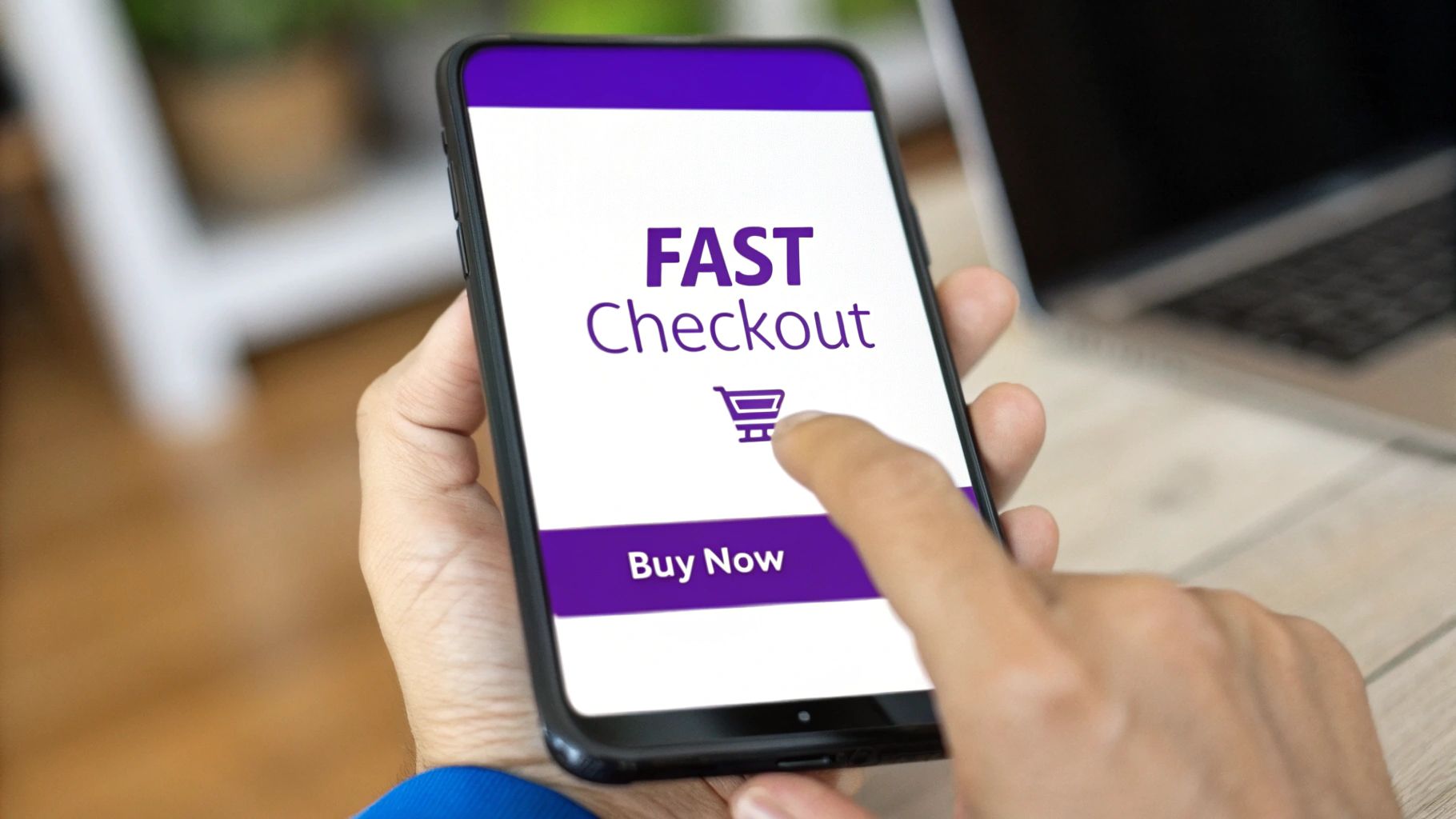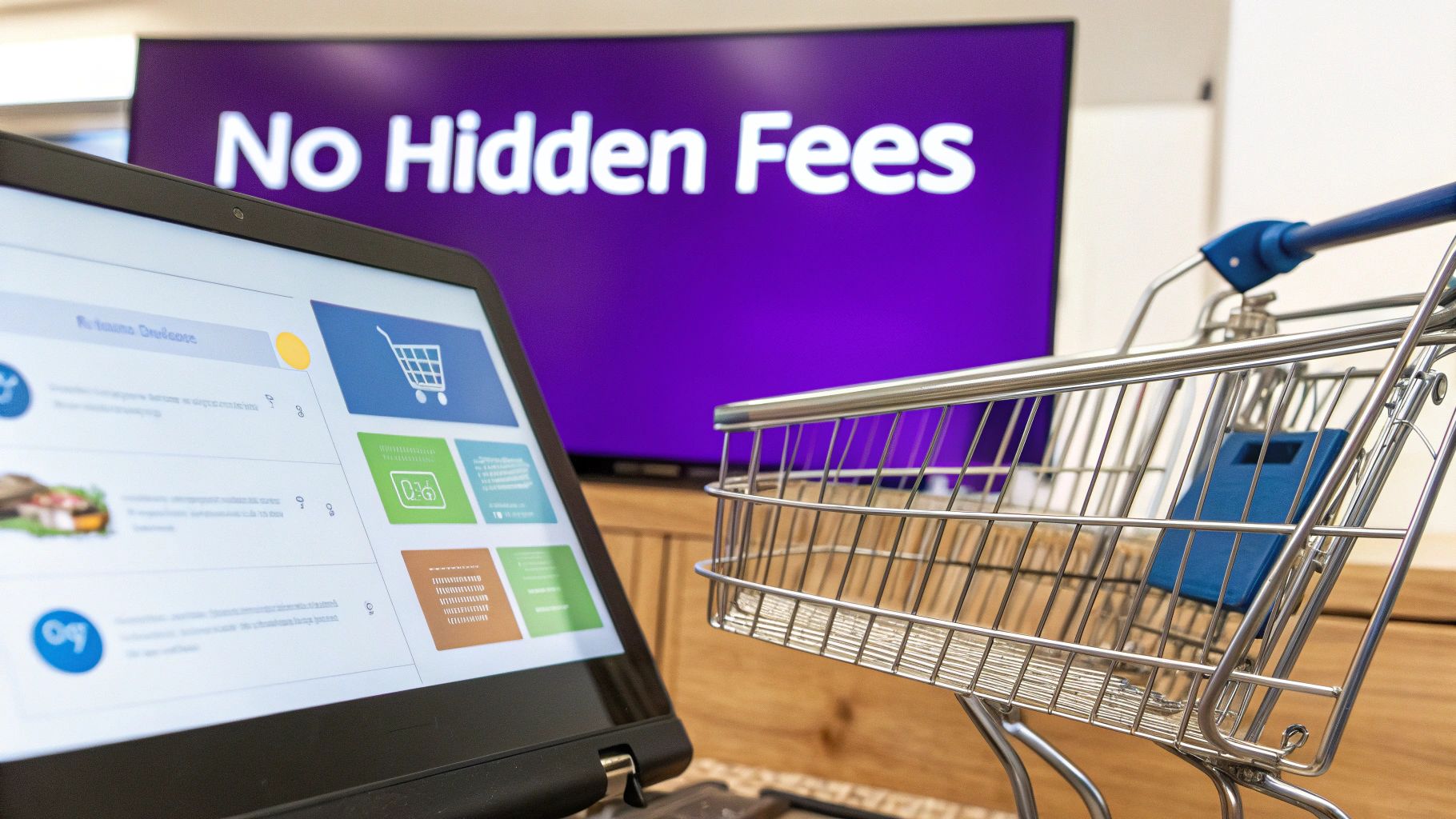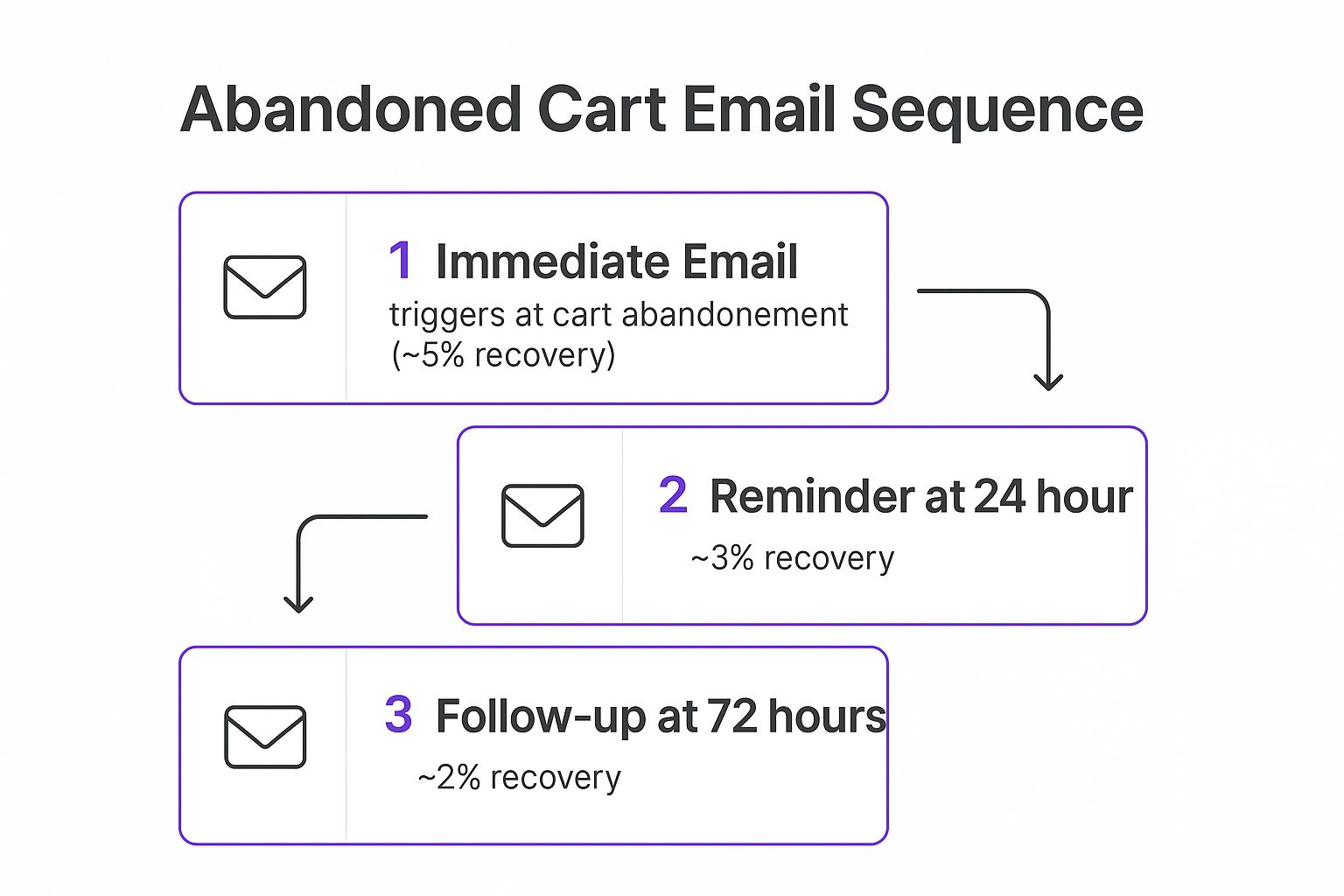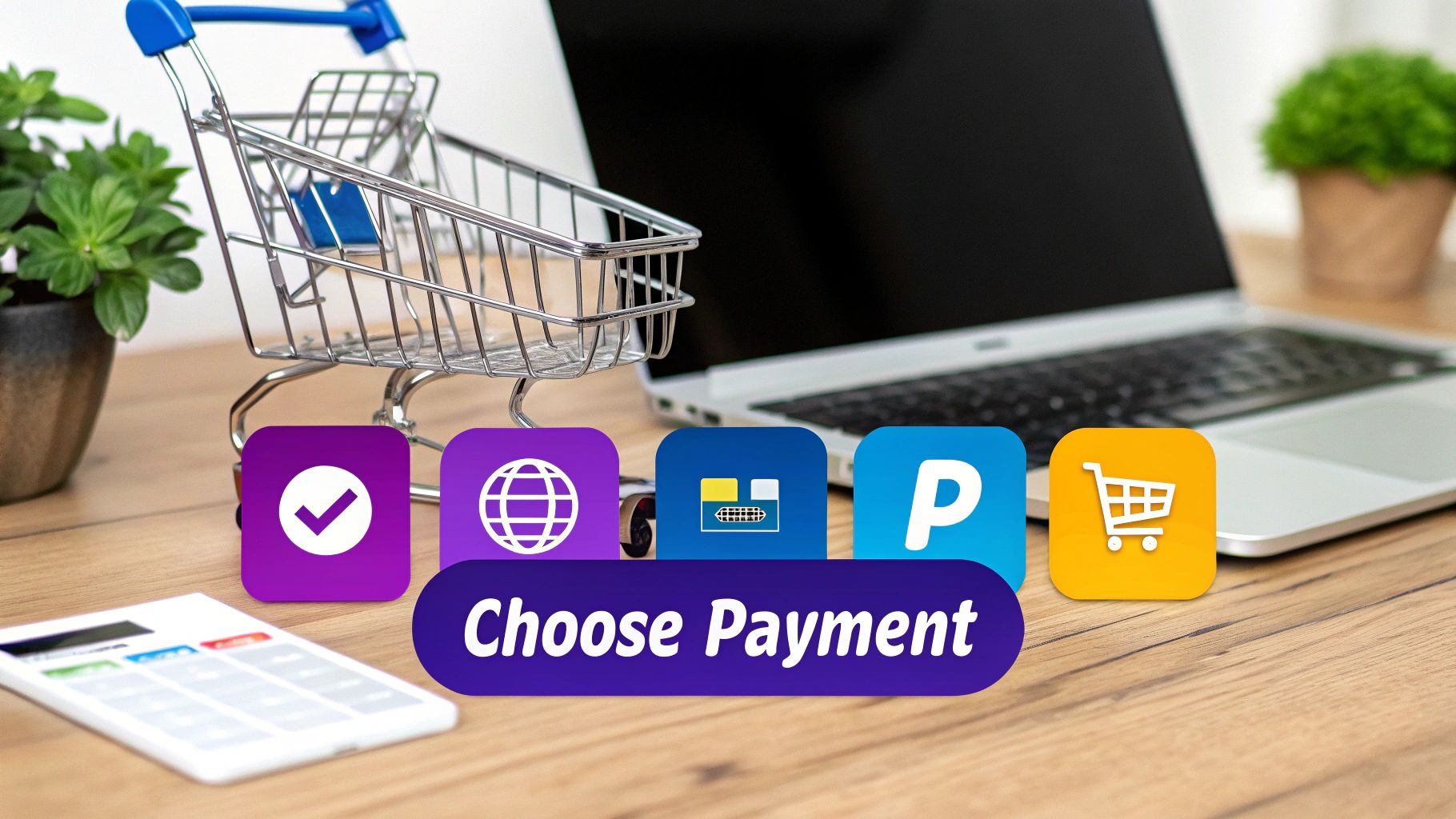How to Reduce Cart Abandonment: Top Strategies for 2025

Stop Losing Sales: Recapture Revenue with These Cart Abandonment Hacks
Is your cart abandonment rate giving you a headache? It's a common e-commerce problem: shoppers adding items to their cart but not completing the purchase. This listicle provides seven proven strategies on how to reduce cart abandonment, helping you convert those almost-sales into actual revenue. Learn how streamlining your checkout, offering various payment options, using exit-intent popups, and more can significantly impact your bottom line. Let's turn those abandoned carts into profits!
1. Streamlined Checkout Process
One of the most effective ways to reduce cart abandonment is by simplifying your checkout process. A streamlined checkout minimizes the steps and information required for a customer to complete a purchase. This reduces friction and makes it significantly easier and faster for them to buy, directly addressing a major cause of cart abandonment: complicated or time-consuming checkout experiences. For businesses processing $20k-$60k per month or Etsy sellers hitting $10k, a clunky checkout can mean a significant loss of potential revenue. Optimizing this area is crucial for growth.

A streamlined process typically features a one-page or minimal-step checkout, often with a progress indicator clearly showing the customer where they are in the process. Think of it as a guided path to purchase, minimizing distractions and confusion. Features like auto-filling fields and smart form validation (which flags errors in real-time) further enhance the experience. It's also critical that your checkout is mobile-optimized, as a growing number of customers shop on their smartphones.
Why This Matters: This deserves its place on the list because checkout experience directly impacts conversions. A smooth checkout translates to happier customers and more sales. Just look at the giants: Amazon's one-click ordering revolutionized online shopping (holding the patent until 2017), Shopify’s accelerated checkout with Shop Pay reports 4x faster checkout times, and ASOS saw a 50% reduction in cart abandonment after streamlining their checkout. These are powerful examples of how impactful this one change can be.
Pros:
- Reduced Abandonment: Fewer steps and less friction directly translate to lower cart abandonment rates.
- Improved Conversions: Easier checkouts lead to more completed purchases, boosting your bottom line.
- Happy Customers: A positive checkout experience increases customer satisfaction and encourages repeat business.
- Time Savings: Faster checkouts save your customers time, making them more likely to purchase from you again.
Cons:
- Development Resources: Implementing a truly streamlined checkout can require significant development work, especially for older platforms.
- Information Balance: Finding the balance between a simple checkout and collecting necessary information can be tricky.
- Ongoing Optimization: Like any conversion optimization strategy, a streamlined checkout requires continuous testing and refinement.
Actionable Tips for Implementation:
- Minimize Form Fields: Only ask for absolutely essential information. Everything else adds friction.
- Address Auto-Complete: Integrate address finder tools to speed up the process.
- Inline Validation: Use inline validation to highlight errors in real-time, preventing frustration at the submission stage.
- Guest Checkout: Offer a guest checkout option to avoid forcing account creation.
- User Testing: Regularly conduct user testing to identify and address any remaining pain points.
Examples in Action:
- Amazon: Their one-click ordering, though no longer patent-protected, set the standard for streamlined checkouts.
- Shopify (Shop Pay): This accelerated checkout system has significantly reduced checkout times for Shopify merchants.
- PayPal (Express Checkout): Allows customers to checkout using their PayPal account, bypassing lengthy form filling.
By focusing on these tips and learning from the examples of successful implementations, you can create a checkout process that minimizes friction, maximizes conversions, and ultimately helps you reduce cart abandonment and grow your business.
2. Transparent Pricing and Shipping Costs
Unexpected costs are a major deal-breaker for online shoppers. Imagine finding the perfect item, adding it to your cart, and then getting hit with unexpected shipping fees or taxes at the checkout. Frustrating, right? This is why transparent pricing and shipping costs are crucial for reducing cart abandonment and boosting your sales. This strategy involves clearly displaying all costs associated with a purchase upfront – product prices, shipping fees, taxes, and any other additional charges. By being upfront about costs, you build trust with your customers and avoid that dreaded last-minute sticker shock that sends potential buyers clicking away.

For e-commerce businesses doing $20k-$60k per month, or Etsy shop owners hitting $10k and above, this is especially important. You've gained traction, but optimizing your site for conversions is key to scaling further. Addressing cart abandonment directly impacts your bottom line. This approach works because it removes a major pain point in the customer journey. Nobody likes surprises, especially when it comes to their money. By providing clear and concise cost information, you empower customers to make informed decisions, leading to a smoother checkout process and increased conversions.
Features of a transparent pricing strategy include:
- Early display of shipping costs or calculator tools: Let customers know shipping costs on product pages or even earlier in the browsing experience. A shipping calculator allows them to estimate costs based on their location.
- Real-time tax calculation: Display accurate tax calculations based on the customer's shipping address.
- Clear indication of any additional fees: If there are any handling fees or other charges, be upfront about them.
- Total cost breakdown at cart stage: Provide a detailed breakdown of all costs before the customer proceeds to checkout.
- Visibly promoted free shipping thresholds: If you offer free shipping above a certain order value, make sure it's clearly displayed throughout the shopping journey.
Pros:
- Directly addresses the top reason for cart abandonment.
- Builds trust with customers through transparency.
- Reduces sticker shock at final checkout stages.
- Can turn shipping into a marketing advantage (e.g., free shipping offers).
Cons:
- May highlight high shipping costs that could deter some purchases.
- Requires integrations for accurate real-time calculations.
- Free shipping offers can impact profit margins (but can be offset by increased average order value).
Examples of successful implementation:
- Zappos: Pioneered free shipping both ways, setting a new industry standard and fostering customer loyalty.
- Everlane: Built its brand on "radical transparency," showing detailed cost breakdowns of their products, including materials, labor, and markup.
- Target: Implementing clear free shipping thresholds has demonstrably increased average order value.
Actionable Tips for Your E-commerce Store:
- Display shipping costs early: Integrate shipping cost information on product pages or even category pages.
- Implement a shipping calculator: Allow customers to get accurate shipping estimates based on their location and chosen shipping method.
- Promote free shipping thresholds: Encourage larger orders by highlighting free shipping offers. For example, "Free shipping on orders over $50!"
- Consider building shipping into product prices: If feasible, factor shipping costs into your product prices and offer "free shipping." This simplifies the pricing structure for customers.
- Test different messaging: Experiment with different ways of presenting shipping costs to find what resonates best with your target audience.
By implementing these strategies, you can significantly reduce cart abandonment, build customer trust, and ultimately increase your sales. Transparency isn't just a trend – it's a fundamental principle of building a successful e-commerce business. For businesses at your level, optimizing this aspect of your online store can translate to significant revenue growth.
3. Abandoned Cart Email Recovery Campaigns
One of the most effective ways to combat cart abandonment and recapture lost sales is through targeted email campaigns. This strategy involves automatically sending personalized email sequences to customers who have added items to their cart but left your site without completing the purchase. These emails serve as gentle reminders, showcasing the items they left behind and often sweetening the deal with incentives to encourage them to return and finish checking out. This tactic is particularly effective for e-commerce businesses experiencing significant traction, like those doing $20k-$60k per month, where even a small percentage recovery can translate to significant revenue gains.

The infographic above illustrates the typical flow of an abandoned cart email recovery campaign. It begins with a customer adding items to their cart and then leaving without purchasing. This triggers the first email, a gentle reminder. If there's no response, subsequent emails follow, often with increasing incentives. The final email might offer a significant discount or emphasize the limited availability of the items. This structured approach gradually increases the likelihood of recovery without overwhelming the customer.
Abandoned cart recovery emails work by re-engaging customers at crucial points after they've shown initial interest. Features like personalized product displays, strategic email timing (immediate, 24 hours, 72 hours later), and enticing incentives like discount codes or free shipping can significantly impact conversion rates. Clear call-to-action buttons leading directly back to their cart make it easy for customers to complete their purchase.
This approach boasts several advantages. It offers a highly effective recovery method with average recovery rates of 10-15%, allowing you to reclaim a significant portion of potentially lost revenue. The return on investment (ROI) is easily measurable, providing clear insights into the campaign's effectiveness. Furthermore, the entire process can be fully automated once set up, requiring minimal ongoing management. It also provides a valuable opportunity for customer engagement and feedback. However, it’s important to be mindful of the potential downsides. This strategy relies on capturing the customer's email address before they abandon their cart, and poorly implemented campaigns can lead to customer annoyance. Over-reliance on discounts can also train customers to intentionally abandon carts in hopes of receiving a better offer.
For example, Adidas recovered 7% of abandoned carts with a three-email sequence, while Dote Shopping achieved a remarkable 33% recovery rate through personalized emails. Whisky Loot also experienced a 20% sales increase thanks to their cart abandonment emails. These examples demonstrate the significant potential of this strategy.
Want to improve your overall strategy for minimizing lost sales? Check out this helpful resource on how to reduce cart abandonment from ECORN. Looking for practical ways to win back lost sales? This comprehensive guide offers actionable strategies on how to reduce cart abandonment and boost conversions, covering everything from optimizing checkout flows to implementing effective email recovery campaigns.
Here are some actionable tips to maximize your success with abandoned cart email recovery:
- Capture email addresses early: Implement email capture fields early in the checkout process, even before customers reach the cart page.
- Optimize subject lines: A/B test different subject lines to determine what resonates best with your audience and drives higher open rates.
- Visual reminders: Include high-quality product images and detailed descriptions in your recovery emails to reignite customer interest.
- Create urgency: Incorporate time-limited offers or highlight limited stock availability to encourage immediate action.
- Strategic sequencing: Implement a series of 3-5 emails with progressively increasing incentives.
- Personalization: Tailor email content based on customer browsing history, cart contents, and past purchase behavior.
Popular platforms like Klaviyo (specialized in e-commerce email marketing), Shopify (built-in abandoned cart recovery), and Omnisend (multi-channel abandoned cart recovery) provide the tools and features necessary to implement robust abandoned cart email campaigns. For Etsy shop owners processing at least $10k per month and e-commerce businesses seeking to optimize their website and boost sales, implementing abandoned cart email recovery is a crucial step towards maximizing revenue and fostering stronger customer relationships.
4. Multiple Payment Options
One of the most frustrating reasons for cart abandonment is the lack of a preferred payment method. Imagine having a customer ready to buy, only to lose them at the final hurdle because you don't offer their preferred way to pay. Offering multiple payment options is a key strategy to reduce cart abandonment and boost your sales. By providing a diverse range of payment methods, you cater to different customer preferences, needs, and even global audiences with varying payment customs. This removes a significant barrier to purchase completion and streamlines the checkout process.

This strategy is particularly crucial for e-commerce businesses processing $20k-$60k per month and Etsy shop owners exceeding $10k in monthly sales. At this level, you're likely attracting a diverse customer base, and catering to their individual payment preferences becomes vital for sustained growth. Think of it as removing friction from the buying process—the easier it is for customers to pay, the more likely they are to complete the purchase.
This approach involves integrating various payment gateways into your online store. Features can include traditional credit/debit card processing, digital wallets like PayPal, Apple Pay, and Google Pay, Buy Now, Pay Later (BNPL) services such as Klarna, Affirm, and Afterpay, and even alternative options like cryptocurrency or bank transfers. For international markets, supporting local payment methods is essential for maximizing conversions.
Benefits and Drawbacks:
The pros of offering multiple payment options are compelling. It accommodates diverse customer preferences and directly increases conversion rates by removing payment barriers. BNPL options can also entice customers and increase average order value. Expanding your market reach to international customers becomes significantly easier with localized payment methods.
However, there are also drawbacks to consider. Each payment gateway adds complexity and maintenance requirements to your system. Different fee structures can impact your profit margins, and managing security and fraud prevention across multiple systems can be challenging. Integrating these gateways with your existing e-commerce platform might also present technical hurdles.
Examples of Success:
Several companies have demonstrated the power of multiple payment options. ASOS saw a 14% increase in conversions after integrating Klarna, proving the impact of BNPL services. Gymshark's successful global expansion is partly attributed to their diverse payment offerings. Similarly, Etsy's support for local payment methods has significantly contributed to its growth in international markets.
Actionable Tips for Implementation:
- Prioritize: Don't feel pressured to offer every payment method under the sun. Focus on the preferences of your target audience and geography. Analyze your sales data and customer surveys to understand what they use most.
- Early Visibility: Display accepted payment options early in the shopping journey, not just at the checkout. This reassures customers and reduces surprises later on.
- Mobile Optimization: Ensure a smooth mobile payment experience for each payment method. Mobile commerce is huge, and a clunky mobile checkout can be a major deterrent.
- Security First: Clearly communicate your security measures to build trust. Display security badges and SSL certificates prominently.
- Analyze and Promote: Track which payment methods have the highest completion rates and subtly promote them during the checkout process.
- Incentivize: Consider offering small incentives, like free shipping or a minor discount, for using preferred payment methods to encourage adoption.
By strategically implementing multiple payment options, you can significantly reduce cart abandonment, improve the customer experience, and ultimately, boost your bottom line. This makes it a crucial tactic for any e-commerce business aiming for sustainable growth and increased revenue.
5. Exit-Intent Popups with Incentives
Seeing a potential customer abandon their cart can be frustrating. You've worked hard to get them to that point! One effective way to combat cart abandonment and recover those almost-lost sales is by using exit-intent popups with incentives. This tactic deserves its place on this list because it allows you to engage with customers at the critical moment they're about to leave, offering them a compelling reason to stay and complete their purchase. For Etsy shop owners hitting $10k+ monthly, growing e-commerce stores in the $20k-$60k range, and anyone with a website showing traction but needing improvement, exit-intent popups can be a game-changer.
How Exit-Intent Popups Work:
Exit-intent technology uses mouse-tracking to detect when a user is about to leave your website. Think of it as a virtual tap on the shoulder just as they're heading for the door. This triggers a popup window with a targeted message or offer, specifically designed to recapture their attention. For cart abandonment, these popups typically offer incentives like discount codes, free shipping, or a bonus gift to persuade customers to finalize their purchase rather than leaving empty-handed.
Features & Benefits:
- Targeted Offers: Customize the popup's content based on the items in the user's cart, the total cart value, or even their browsing history. For instance, offer free shipping on orders over a certain amount, or a discount on a related product.
- Incentive Variety: Offer a range of incentives – percentage discounts, dollar-off discounts, free shipping, free gifts, or even access to exclusive content.
- Email Capture: Even if a customer doesn't complete their purchase after seeing the popup, you can still capture their email address. This allows you to follow up with personalized email marketing campaigns and nurture them towards a future purchase.
- A/B Testing: Most exit-intent popup tools offer A/B testing capabilities, allowing you to experiment with different offers, headlines, and designs to find the most effective combination for your audience.
- Measurable Results: Track key metrics like conversion rates, recovery rates, and the overall impact on your bottom line, making it easy to assess the effectiveness of your exit-intent strategy.
Examples of Success:
- Bitdefender: Increased conversions by a whopping 51% using exit-intent popups with targeted offers.
- BarkBox: Recovered 25% of abandoning visitors by presenting them with enticing exit offers.
- Spreadshirt: Boosted sales by 9% simply by implementing exit-intent technology.
Pros & Cons:
Pros:
- Recapture customers at the brink of abandonment.
- Provide an immediate incentive to complete the purchase.
- Build your email list for future marketing efforts.
- Highly measurable to optimize performance.
- Personalization potential based on individual customer behavior.
Cons:
- Can be perceived as intrusive if not implemented carefully.
- Potential to train customers to expect discounts.
- Less effective on mobile devices where exit intent is harder to detect.
- May negatively impact brand perception if overused or poorly designed.
Actionable Tips for Implementation:
- High-Value Offers: Make sure your incentives are genuinely valuable to the customer. A paltry 2% discount isn't likely to sway anyone.
- Strategic Thresholds: Set minimum cart values for discount offers to protect your profit margins. For example, offer free shipping on orders over $50.
- Urgency & Scarcity: Create a sense of urgency by using time-limited offers, like "This offer expires in 10 minutes!"
- Personalization is Key: Tailor your messaging based on the contents of the cart or the user's browsing history.
- Brand Consistency: Maintain a consistent design aesthetic that aligns with your brand. The popup should feel like a natural extension of your website.
- Test and Refine: A/B test different types of incentives and messaging to see what resonates best with your audience.
- Frequency Capping: Limit the frequency of popups to avoid annoying your customers and causing "popup fatigue." Don't bombard them with multiple popups in a single session.
Popular Exit-Intent Tools:
- OptinMonster: A leading provider of exit-intent technology.
- Privy: An e-commerce focused exit-intent solution.
- Sumo: An early innovator in exit-intent popup technology.
By implementing exit-intent popups strategically and thoughtfully, you can effectively reduce cart abandonment, recover lost sales, and boost your bottom line. Just remember to focus on providing real value to your customers, and don't overdo it!
6. Trust Signals and Security Reassurance
One of the most effective ways to reduce cart abandonment and boost your sales is by building trust with your customers. Think about it – would you hand over your credit card details to a website that looks sketchy? Probably not. That's where trust signals and security reassurance come in. This strategy focuses on prominently displaying elements that assure customers of your legitimacy and the safety of their information, ultimately encouraging them to complete their purchase. This is crucial for minimizing cart abandonment and is particularly important for e-commerce businesses processing $20k-$60k per month who are looking to scale and optimize their conversion rates. Etsy shop owners exceeding $10k in monthly sales can also benefit greatly from implementing these techniques on their external websites, driving further growth.
How it Works: Trust signals act as virtual handshakes, telling your customers, "Hey, we're a legitimate business, and your information is safe with us." These signals range from simple security badges to detailed return policies, all working together to create a sense of security and confidence.
Features to Implement:
- SSL Certificate and Secure Checkout Indicators: The padlock icon in the address bar and "https" are non-negotiable. They're the baseline for online security.
- Payment Processor Security Badges (Visa, Mastercard, PayPal Verified): Displaying familiar payment logos assures customers that their preferred methods are accepted and secure.
- Third-Party Trust Seals (Norton, McAfee, Trustpilot): These badges, often from well-known security companies or review platforms, add an extra layer of credibility.
- Customer Reviews and Testimonials: Authentic reviews from other shoppers are powerful social proof, demonstrating your product's value and your reliability.
- Clear Return and Refund Policies: A transparent and customer-friendly return policy can alleviate purchase anxieties.
- GDPR Compliance Information (if applicable): Showing you respect data privacy builds trust, especially with international customers.
Why This Deserves a Place on the List: For Etsy sellers branching out with their own websites and businesses doing $20k-$60k monthly, cart abandonment can significantly impact revenue. Addressing security concerns head-on is a low-hanging fruit that can significantly improve conversions and pave the way for sustainable growth.
Pros:
- Directly addresses security concerns that cause abandonment.
- Builds credibility, especially for newer or less-known brands.
- Increases customer confidence during critical decision moments.
- Relatively easy to implement compared to complex technical changes.
Cons:
- Some trust badges require paid subscriptions or certifications.
- Overuse of badges can create visual clutter.
- Effectiveness varies by customer demographic and region.
- Requires maintaining actual security standards to match the promises displayed.
Examples of Success:
- Blue Fountain Media: Increased conversions by 42% by adding trust seals to their checkout.
- Petco: Prominent display of the Norton Secured seal increased checkout completions by 8.83%.
- CXL Institute: Found that adding security badges to a financial services site lifted conversions by 32%.
Actionable Tips for Reducing Cart Abandonment with Trust Signals:
- Strategic Placement: Place trust signals prominently near points of transaction or decision, such as the add-to-cart button, checkout page, and payment forms.
- Contact Information: Display customer service contact information during checkout to reassure customers that help is readily available.
- Real-Time Information: Showing real-time inventory and delivery information increases transparency and reduces uncertainty.
- Highlight Guarantees: Emphasize money-back guarantees and hassle-free returns to minimize perceived risk.
- Authentic Reviews: Use genuine customer reviews rather than generic testimonials for increased credibility.
- A/B Test: Experiment with different trust signals and placements to find what resonates best with your target audience.
Popularized By:
- Norton: Pioneered security seals for e-commerce, setting a standard for online trust.
- Trustpilot: Made customer reviews a mainstream trust signal, leveraging the power of social proof.
- PayPal: Buyer protection programs significantly increased trust in online payments, especially for newer e-commerce platforms.
By strategically implementing these trust signals and consistently prioritizing actual security measures, you can effectively reduce cart abandonment, build a loyal customer base, and drive substantial revenue growth for your business.
7. Real-time Customer Support and Chat
One of the most effective ways to reduce cart abandonment and boost your sales is by offering real-time customer support and chat. This approach provides immediate assistance to shoppers as they navigate your site, addressing their questions and concerns at the crucial moment they arise. For Etsy shop owners pulling in $10k+/month, growing e-commerce businesses in the $20k-$60k/month range, and anyone looking to optimize their website for conversions, real-time support can be a game-changer in tackling cart abandonment.
Here's how it works: Imagine a customer is hesitant about sizing or shipping costs during checkout. Instead of abandoning their cart, they can instantly connect with a support agent or chatbot to get their questions answered. This immediate support can make the difference between a lost sale and a completed purchase.
Features that Make a Difference:
- Live Chat with Human Agents: Especially crucial during peak shopping hours, having real people available to chat builds trust and provides personalized assistance.
- AI-Powered Chatbots: Offer 24/7 support for common questions, freeing up your team to focus on more complex issues.
- Proactive Chat Triggers: Based on user behavior, like lingering on a product page or repeatedly visiting the cart, you can initiate chats to offer assistance proactively. This is particularly effective for hesitant buyers.
- Co-browsing: For more complex issues, co-browsing allows your agents to virtually guide customers through the purchase process, providing a hands-on approach to support.
- CRM Integration: Connect your chat system with your CRM to access customer history and offer truly personalized support.
- Multi-channel Support: Extend real-time support beyond your website to messaging apps and social media, meeting customers where they are.
Why Real-time Support Deserves its Place in Your Strategy:
This strategy directly addresses the reasons why customers abandon their carts – uncertainty, confusion, and unanswered questions. By providing immediate solutions, you build confidence and encourage completion of the purchase. It’s particularly valuable for businesses like yours experiencing consistent traction but looking for that next level of growth.
Pros & Cons:
Pros:
- Immediate Problem Solving: Resolves issues before they lead to abandonment.
- Personalized Experience: Creates a tailored shopping journey.
- Valuable Insights: Provides data on customer pain points and areas for improvement.
- Upselling/Cross-selling Opportunities: Agents can suggest related products or upgrades.
- Relationship Building: Fosters loyalty and repeat business.
Cons:
- Resource Intensive: Live chat requires staffing and training.
- Chatbot Limitations: Poorly designed chatbots can frustrate customers.
- Implementation Costs: Setting up and maintaining the systems can be an investment.
- Dependency: Customers may become reliant on instant support.
Real-World Success Stories:
- Virgin Atlantic increased conversion rates by 3.5x using proactive chat.
- Intuit saw a 20% reduction in cart abandonment after implementing live chat during checkout.
- Sephora's chatbot boosted mobile conversions by 11% through personalized product recommendations.
Actionable Tips for Implementation:
- Train Your Team: Focus training on checkout issues and objection handling.
- Proactive Engagement: Set up triggered chats for hesitant behavior.
- Easy Accessibility: Make sure the chat widget is highly visible throughout the checkout process.
- Strategic Chatbot Use: Use bots for initial engagement and simple questions, seamlessly handing off to human agents for complex issues.
- Analyze Chat Transcripts: Identify recurring problems in the purchase process.
- Empower Your Agents: Give them the authority to offer incentives, like discounts or free shipping, to close sales.
Key Players in the Field:
Companies like Zendesk, Intercom, and Drift have pioneered various aspects of real-time customer support, offering robust platforms and innovative solutions. Researching their offerings can help you determine the best fit for your business.
By implementing real-time support strategically, you can significantly reduce cart abandonment, enhance customer satisfaction, and drive sales growth. This approach is not just about answering questions; it's about building relationships and creating a positive shopping experience that encourages customers to return.
7 Strategies to Reduce Cart Abandonment
Ready to Transform Your E-commerce Sales?
Reducing cart abandonment is crucial for any online business aiming for sustainable growth. We've explored seven powerful strategies to combat this challenge, from streamlining your checkout process and offering transparent pricing to implementing effective email recovery campaigns and leveraging exit-intent popups. Remember, the key takeaways here are optimizing for convenience, building trust, and providing exceptional customer support. By focusing on these core principles, you can significantly decrease cart abandonment rates and reclaim those almost-lost sales. This translates directly to a healthier bottom line and allows you to reinvest in your business, expand your reach, and ultimately achieve your e-commerce goals. Mastering these techniques puts you firmly in control of your sales funnel, turning potential customers into loyal brand advocates.
Ready to take your Shopify store to the next level and minimize cart abandonment? Partner with Wand Websites and leverage our expertise in building high-converting Shopify stores designed to recapture lost revenue and drive sustainable growth. We'll help you implement the strategies discussed in this article, ensuring your store is optimized for conversions from checkout to customer loyalty.


